Maximizing Cake Flavor with Slider Cake Pans
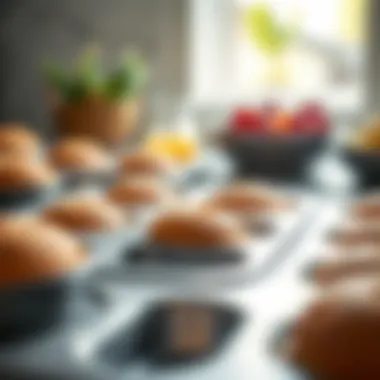
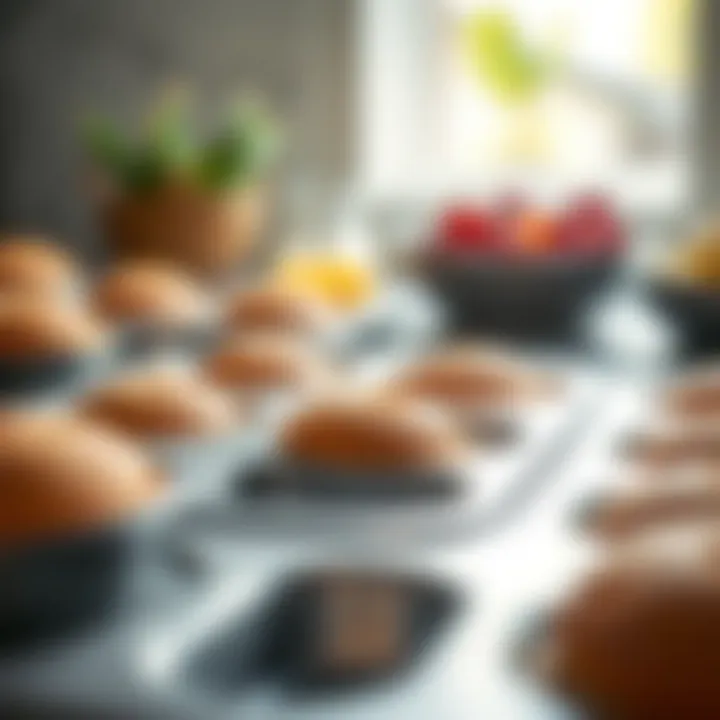
Intro
In the world of baking, the tools often make the most significant impact on the end result. One such innovative tool that's gaining momentum is the cake pan with sliders. This clever design not only brings functionality but also brings a touch of modernity to the classic art of cake making. Imagine slicing and lifting your cake with ease, all while maintaining its structure and presentation. Whether you're a budding baker or a seasoned pastry chef, these pans can make your baking experience smoother and more enjoyable.
As this article unfolds, we'll delve into the multifaceted aspects of cake pans with sliders. From their structural advantages to their practical applications, you'll soon see that these pans are more than just kitchenware; they could become the unsung hero of your baking endeavors. Let’s roll up our sleeves and explore the versatility of these innovative baking tools.
Foreword to Cake Pans with Sliders
Baking is much more than just mixing ingredients; it’s an art, a science, and for many, a beloved pastime. Over the years, baking tools have evolved significantly, leading to innovations that enhance both the process and the final outcome. One such advancement is the cake pan with sliders, a versatile tool that offers numerous benefits for both amateur and professional bakers.
These cake pans feature a unique slider mechanism that allows for easier cake removal, reducing the risk of damage to your baked goods. Imagine trying to extract a delicate chocolate mousse cake from a traditional pan - one wrong move, and the whole thing could crumble. With a slider pan, that's not a concern. You can glide the cake out effortlessly, preserving its shape and texture.
Additionally, the design of these pans lends itself to consistent baking results. They often come in various shapes and sizes and are engineered to promote even heat distribution. No more awkwardly browned edges or undercooked centers! Every slice you serve will be uniformly baked, pleasing both the eye and the palate.
Understanding Slider Mechanisms
The mechanism of a slider pan is ingeniously simple yet effective. Typically, these pans are composed of two separate sections. You have the outer shell, which doesn’t come apart, and the inner base where the cake actually bakes. The beauty lies in the sliding action that pops the cake out without the usual tug-and-tear associated with traditional methods. As a result, this design not only maintains the integrity of the cake but also allows for decorative work to be done without hassle.
This set-up becomes an ally when creating more intricate desserts, such as cheesecakes or tortes, which demand a gentle release to avoid cracks or uneven surfaces.
Overall Structure and Design
When you dive into the structure and design of slider cake pans, you'll notice a robust build that caters to both durability and functionality. Many models are made from materials like aluminum or heavy-gauge steel, which provide excellent heat conduction, ensuring your cakes are baked evenly. Moreover, non-stick surfaces are often an added bonus, making cleanup a breeze.
The sleek contours and streamlined design of slider pans contribute not just to aesthetics but also to their usability. A common gripe with standard pans is that sometimes, the batter can seep into seams or crevices, leading to an unsightly mess. With slider pans, most designs minimize these gaps, leading to a cleaner experience.
To illustrate some important attributes of these pans, consider the following:
- Material Matters: High-quality materials ensure longevity, even heat distribution, and ease of use.
- Ease of Use: The simplicity of the slider mechanism speaks to bakers of all skill levels, making precise baking accessible.
- Versatility in Design: With various shapes in the market, bakers can experiment widely—from elegant round cakes to unique novelty shapes.
In summary, cake pans with sliders are more than just a tool; they embody a fusion of innovation and practicality that caters to modern baking needs. Understanding their design and functionality not only enhances the baking experience but also inspires creativity, leading to a more enjoyable culinary journey.
Benefits of Using Cake Pans with Sliders
When it comes to baking, every detail counts, and choosing the right cake pan can significantly influence the outcome of your culinary endeavors. Cake pans equipped with sliders are not your average baking tools; they bring a new level of versatility and convenience that can transform the baking experience. Let's unmask the multiple benefits that these pans offer, from aesthetics to function, making them an essential choice for both amateur and seasoned bakers.
Easier Cake Release
One of the standout features of cake pans with sliders is their role in facilitating an easier cake release. Imagine whipping up a decadent chocolate cake, only to have it stubbornly stick to the sides of your pan—frustrating, right? These innovative pans are designed with a sliding mechanism which helps you to effortlessly push the cake out after cooling. This means you can achieve perfect, unblemished layers every time. No more chipped edges, no more crumbled pieces—it’s like magic!
Consider this: the material typically used in slider mechanisms is either silicone or a similar flexible compound. This not only aids in release but can also be a game changer for cakes that may require additional layers or fillings. Removing the cake gently preserves the structural integrity, which is particularly crucial for elaborate and multi-layered designs.
Consistent Baking Results
In the realm of baking, consistency is king. A cake pan with a slider mechanism contributes to more uniform baking results. The design usually allows for an even heat distribution, ensuring that your baked goods rise perfectly and cook throughout. It’s a significant feature because even the slightest undercooking or uneven baking can be detrimental, especially in professional settings.
When comparing traditional pans with slider variants, bakers have noticed fewer instances of doming or uneven surfaces. This consistency eases not just the baking process but enhances the final product, providing a better canvas for decoration and presentation. You’re more likely to satisfy the cravings of those who indulge in your baked delights, boosting both your confidence and cellebrity in the kitchen.
Enhanced Aesthetics
Cake presentation can make or break the culinary experience, and cake pans with sliders take aesthetics to another level. The precise edge created by the slider mechanism allows for perfectly symmetrical cakes, which is a definite plus for anyone looking to impress guests or patrons.
Moreover, the ease of cake removal means that your beautiful layers of frosting or garnished toppings won’t get marred by the pan. Cakes can be adorned and styled without the usual concerns over damage during removal. Better yet, slider cake pans often come in a variety of shapes and designs, catering to creative trends in baking that elevate the visual appeal of your culinary masterpiece.
Material Considerations
When diving into the world of cake pans with sliders, material consideration stands as a fundamental aspect that influences not only the baking experience but also the overall quality of the baked goods. Understanding the various materials used in crafting these pans helps in making an informed choice that aligns with both culinary needs and personal preferences. Here we’ll chat about two main elements: non-stick coatings and overall durability, as well as heat resistance, all of which play significant roles in achieving baking success.
Non-stick Coatings
One of the most crucial features in cake pans with sliders is the non-stick coating. This layer aids in the seamless release of cakes from the pan. Imagine for a second trying to flip a beautifully baked cake only to find it glued to the sides of the pan like a stubborn commuter in the morning rush. A quality non-stick surface mitigates this issue, ensuring that cakes slide out effortlessly once they have cooled.
Choosing the right non-stick coating goes beyond mere convenience; it can significantly affect how cakes brown during the baking process.
- Types of Non-stick Coatings: There are several types available such as ceramic, silicone, and traditional chemical-based coatings. Each has its pros and cons. For instance, ceramic is generally more environmentally friendly, while traditional non-stick finishes are tried and true in the baking community.
- Long-term Performance: Over time, even the best coatings can wear down. It’s prudent to pay attention to how the coating reacts to temperature and cleaning. Some may chip or scratch easily if not treated with care.
"A well-coated pan is like a trusty old friend; it helps you shine in the kitchen!"
While non-stick options often come with a higher price tag than their uncoated peers, the investment is reflected in the quality of the results. Good non-stick coatings perform remarkably well, leading to cakes with perfectly browned exteriors and minimal risk of sticking. Therefore, it’s wise to factor this into your decision-making process.
Durability and Heat Resistance
Now, let’s not forget about durability and heat resistance, two key players in the material mix. The materials used can dramatically change how a cake pan performs in high temperatures typical of baking.
- Material Strength: Pans made from thicker metals can withstand higher temperatures and maintain structural integrity even with the heat ramped up. Thinner pans might warp, leading to uneven baking, which can produce cakes that are, well, not what you ordered.
- Heat Conductivity: The choice of materials directly affects heat conductivity. For instance, aluminum pans tend to conduct heat efficiently, which can yield quick and even baking results. Conversely, heavier materials like cast iron, while durable, take longer to heat up and may require adjustments in baking time.
When selecting a cake pan, consider how you'll use it:
- Are you a weekend baker preparing that luxurious layered cake?
- Or a busy individual trying to whip up last-minute desserts? Your baking habits will guide you in choosing materials that best fit your requirements.
Combining non-stick coatings with durable, heat-resistant materials results in reliable cake pans that stand the test of time. A careful selection ultimately leads to pursuing perfection in cake baking.
As you continue this journey into the realm of sliders and their quirky features, let material considerations ground your baking ventures to ensure success in your culinary creations.
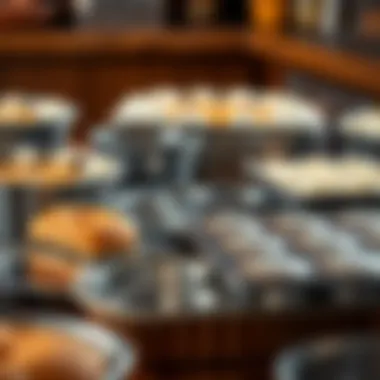
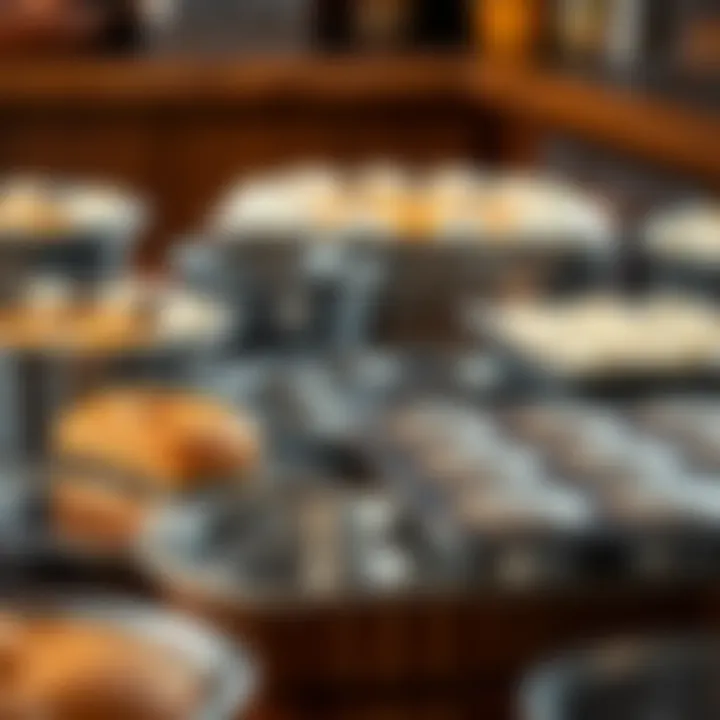
Different Types of Cake Pans with Sliders
When it comes to baking, the shape and design of your cake pan can have a significant impact on your culinary creations. Cake pans with sliders offer versatility in functionality, allowing bakers to experiment with different styles and textures. Understanding the various types of cake pans equipped with sliders can enhance your baking experience and help you produce stunning desserts.
Round Cake Pans
Round cake pans are perhaps the most traditional option for baking cakes, and when paired with a slider mechanism, they become even more user-friendly. These pans generally come in various sizes, making it easy for bakers to create tiered cakes of different heights. The slider function allows for easy removal of the cake, preventing it from cracking or crumbling. Here are some key points:
- Perfect for Layering: Circular shapes lend themselves well to classic layered cakes, whether it's a simple sponge or a rich chocolate torte.
- Even Heating: Round pans often promote even baking, since heat is distributed uniformly around the edges.
- Versatility: Not just for cakes; you can also use them for quiches or casseroles.
Square and Rectangular Cake Pans
Square and rectangular cake pans are fantastic for those who enjoy baking sheet cakes or brownies. The sliding feature allows for easy separation from the edges, which can sometimes be tricky with standard pans. Here’s what to consider:
- Ideal for Sheet Cakes: These pans are perfect for serving a larger crowd and for events like birthdays or family gatherings.
- Simple Portioning: The straight edges help in cutting dough, making equal slice more straightforward for serving.
- Baking Versatility: They can double as a storage pan for lasagna or other baked dishes, showcasing their multi-functional nature.
Novelty Cake Pans
Novelty cake pans are where creativity shines. These pans come in a plethora of whimsical shapes, from cartoon characters to elaborate designs. The inclusion of sliders might not only enhance the ease of use but can also add a unique flair to your baking. Here’s what sets them apart:
- Fun and Creativity: Baking a cake in the shape of a favorite character or object can make any occasion more special, captivating the eyes as well as taste buds.
- Event-Specific Designs: Whether it’s a baby shower, birthday, or holiday gathering, novelty pans can cater to specific themes, adding personal touches to your celebrations.
- Easy Cleanup: Many of these novelty designs can be intricate, however, with the slider feature, you minimize breakage and mess during extraction.
Understanding the differences between round, square, rectangular, and novelty cake pans with sliders allows bakers to choose the best option depending on their recipe and occasion.
"Having the right tools not only makes baking easier but also inspires creativity and experimentation in the kitchen."
Each type serves its purpose while providing the convenience that the sliding feature brings. As you explore the versatility of cake pans with sliders, you’re empowered to let your imagination run wild.
Usage Guidelines
When it comes to using cake pans with sliders, understanding the right usage guidelines is paramount. These pans are designed to simplify the baking process and provide impeccable results, but it’s crucial to follow certain tips to make the most of their features. By adhering to these guidelines, you can avoid common pitfalls and ensure that your baking journey is smooth sailing.
Preheating and Preparation
Getting started, preheating your oven is the first step in achieving a well-baked cake. This ensures even cooking from the get-go. Set your oven to the temperature specified in your recipe. While it warms up, prepare your cake pan with the necessary greasing or lining. While cake pans with sliders often come with non-stick coatings, a touch of butter or baking spray detects any potential sticking incidents.
- Greasing Tips:
- Apply a thin layer of vegetable oil or butter using a pastry brush.
- Dust the interior with flour if you’re using a wet batter that could stick.
Keep your ingredients at room temperature; eggs and butter blend better this way, helping your cake rise perfectly. Measure out everything before starting to streamline the mixing process.
Filling and Baking Techniques
Now, onto the filling and baking techniques, this step is critical for ensuring that your cakes rise and bake uniformly. A common mistake is to overfill the pan. Aim for filling between half and two-thirds full, as cakes expand while baking. If using multiple layers, consider the thickness of each layer; sliders streamline this process by allowing easy removal.
- Mixing Matters:
- Combine dry and wet ingredients separately before mixing. This prevents clumping.
- Use gentle motions when incorporating ingredients, especially with batter, to avoid deflating air pockets built during creaming.
Place the pan in the center of the oven for even heat distribution. Make use of the slider system; after baking, a quick tug on the slider lets you peek at the cake's color. This gives you a chance to check doneness without risking overcooking the edges.
Cooling and Removal Process
Once baking time is up, the cooling and removal process becomes crucial. Let your cake cool in the pan for about 10-15 minutes, as this helps it solidify and minimizes breakage. After this brief wait, utilize the sliders to gently release your cake. Just pull the slider slowly and watch your cake glide out with ease.
- Cooling Tips:
- Place cakes on a wire rack to cool completely, which helps retain the right texture.
- If the cake sticks, slide a thin spatula along the edges to free it up before using the sliders.
This method not only saves you from heartache but also preserves that beautifully crispy edge many bakers strive for. It’s these small tips that differentiate an ok cake from a stellar one.
"Preparation is the key to success; don’t cut corners and you will be rewarded with delightful desserts."
By following these guidelines, you ensure a successful baking experience with your cake pans that feature sliders. Knowing how to preheat properly, fill correctly, and cool efficiently can make all the difference. Happy baking!
Cleaning and Maintenance
Keeping your cake pans in tip-top shape is part and parcel of a successful baking adventure, especially when it comes to those innovative models equipped with sliders. Cleaning and maintenance might seem like a chore, but neglecting it leads to undesired consequences such as sticking cakes or undesirable flavors. Regular upkeep is essential to ensure your pans perform at their best and last for years to come. This section dives into two pivotal aspects: avoiding damage to non-stick surfaces and exploring proper storage solutions.
Avoiding Damage to Non-stick Surfaces
Non-stick surfaces are a lifesaver when it comes to baking cakes; they allow for smooth releases and less hassle in the kitchen. However, these surfaces are more fragile than one might think. It’s crucial to handle them with care. Here are a few strategies to keep them in pristine condition:
- Use utensils made of silicone or wood. Metal spatulas or knives may scratch the surface leading to degradation over time.
- When cleaning, avoid abrasive sponges or harsh detergents; a simple soft cloth or sponge with mild soap will usually do the trick. Give it a rinse and dry it gently.
- Storage matters; stacking non-stick pans can lead to scratches. It helps to place a paper towel between pans to protect their surfaces.
One might think it’s overkill, but proper care pays off when you pull out a perfect cake without any sticking drama.
Proper Storage Solutions
After cleaning, how you store your cake pans is equally important. Storing them thoughtfully prevents damage and helps maintain their quality for future baking escapades. Here’s how to get it right:
- Store pans in a dry, cool place to prevent any damp issues. Humidity can lead to rust in some materials and unwanted growth in others.
- If space allows, hang your pans. Hanging keeps them off surfaces where they could get scratched or punctured.
- If stacking is necessary, make sure to use protective barriers such as dish towels, cloths, or cardboard to prevent scratching and scuffs.
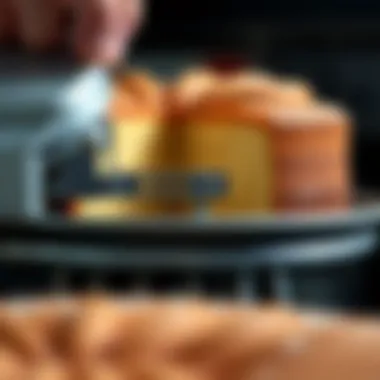
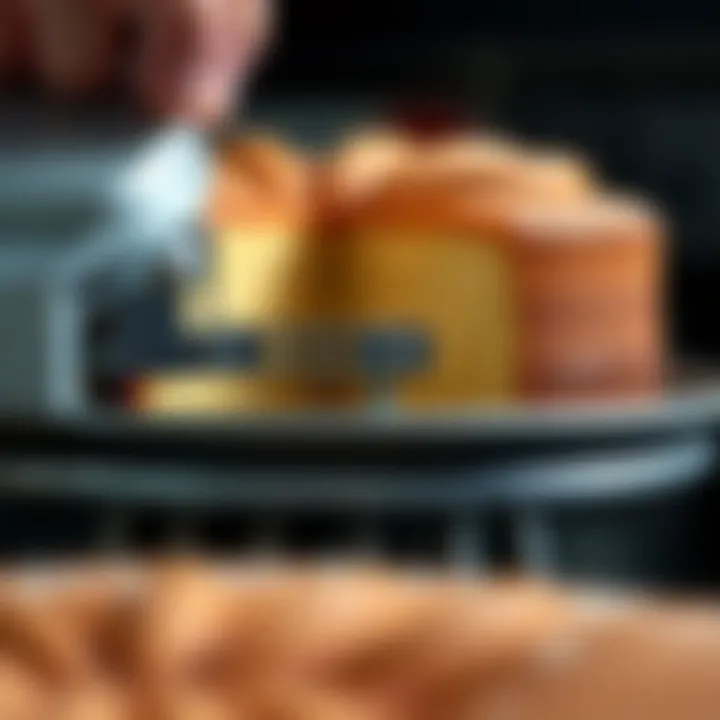
In summary, cleaning and maintaining your cake pans, especially those equipped with sliders, ensures that your baking experience is nothing but delightful. When your tools are cared for, they create masterpieces. By avoiding damage during cleaning and adopting smart storage solutions, you're setting the stage for baking success every time you step into the kitchen.
"A clean pan is like a happy baker. Take care of your tools, and they will take care of you."
For more tips on maintaining kitchen gear, check resources like Wikipedia and Britannica. All of these little efforts make a world of a difference in both performance and longevity.
Creative Baking Ideas Using Sliders
Exploring the world of cake pans with sliders opens up endless possibilities for creative baking. Using these innovative tools can enhance not only the baking process but also the visual and textural appeal of your desserts. They allow for unique layering and filling techniques that can transform a simple cake into a spectacular masterpiece.
Baking enthusiasts often seek ways to showcase individuality in their cakes; sliders enable you to do just that. The design and functionality of these pans facilitate intricate creations that are usually reserved for professional bakers or bakery displays. Here are a couple of creative ways these pans can elevate your baking game.
Layered Cakes
Layered cakes are a showstopper at any gathering, and cake pans with sliders make creating these eye-catching desserts a breeze. The sliders’ design enables you to bake each layer uniformly, ensuring consistent thickness. This is more than just a practical advantage; it enhances the cake's presentation.
- Versatile Flavors: With multiple layers, you can mix various flavors together. One layer could be chocolate while the next is vanilla, and a hint of raspberry filling or lemon curd can bridge the gap between the two. The options are limitless!
- Easy Assembly: Once baked, pulling the layers apart can be a hassle. The slider mechanism allows for easy separation without the usual risks of crumbling or splitting layers. You can assemble your cake right away without mess, making the process more enjoyable.
"Using cake pans with sliders makes it easier than ever to create stunning layered cakes that truly impress!"
Additionally, attention to detail becomes second nature when you work with slider pans. You can incorporate fillings like mascarpone, whipped cream, or fresh fruit in between layers, seamlessly blending tastes and textures for a delightful experience. Instead of worrying about cake stability, you can focus on decorating your layered creation with frosting, berries, or edible flowers, making it a centerpoint of any party.
Stuffed Cakes
Stuffed cakes are an exciting trend that elevates the traditional cake by combining flavors in a way that delights the palate. With cake pans that feature sliders, you're set up for success in creating these unique desserts.
- Delicious Fillings: Think beyond the classic layers. You can include fillings such as caramel, mousse, or even a rich ganache right inside your cake. The novelty of discovering a flavorful surprise in each slice can be a fantastic twist.
- Moisture Retention: Cakes that are stuffed often maintain their moisture better, as the filling can add a layer of protection during baking. This keeps your cakes fresh and delicious longer, making leftovers a treat rather than a task.
Baking a stuffed cake can be just as rewarding as it sounds. The sliders simplify the removal of each layer, allowing for easier stuffing without the struggle often associated with other designs, particularly when attempting complex configurations. When the final cake is sliced, the beauty of multiple colors, tastes, and textures become apparent, delighting both the eyes and the tastebuds.
Whether you are entertaining guests or indulging your own sweet tooth, utilizing sliders in cake pans offers countless avenues for creativity. From layered cakes that turn heads to stuffed cakes that satisfy cravings, these innovations in baking allow you to explore your culinary boundaries, making each baking session both a journey and a destination.
Common Mistakes to Avoid
When delving into the world of baking, even seasoned bakers can find themselves making a misstep or two, especially when using innovative tools like cake pans with sliders. Understanding common blunders can prevent frustration and help achieve better baking results. The importance of exploring these mistakes lies not just in avoiding disasters, but also in enhancing the overall baking experience. Each error provides insight into the nuanced relationship between technique and outcome. Avoiding these pitfalls allows bakers to appreciate the versatility of slider pans fully, leading to delightful desserts and happy taste buds.
Overfilling the Pan
One of the most frequent errors is overfilling the cake pan. While it might seem appealing to want a tall, luscious cake, overloading can have adverse effects. A cake batter that spills over can lead to an uneven bake. When batter runs over the sides, it’s not only messy but may scorch on the oven floor, leading to an unnecessary clean-up session.
Moreover, an overflowing cake can compromise the structure of the baked good. As it rises, if it's too full, it can collapse under its weight. Remember, cakes expand while baking, and there's a fine line between abundance and excess. A good rule of thumb is to fill the pan no more than two-thirds full. This ensures that your cake has enough room to rise without transforming your oven into a disaster zone.
Ignoring Baking Times
Another common pitfall is disregarding baking times, which can happen to the best of us. Each recipe provides a guideline, but personal ovens may behave differently. Overlooking the specifics might lead to cakes that are either undercooked or overdone. The slider mechanism in these pans offers a significant advantage here – you can easily check the cake’s doneness without compromising its structure.
Judging by appearance alone can be misleading; a golden-brown top doesn’t always indicate that the inside is baked through. Using a toothpick to test for doneness is a reliable technique. If it comes out clean, your cake’s ready. Ignoring careful timing can result in disappointing outcomes, so keep an eye on the clock. Paying attention to details like this helps ensure every slice is a slice of heaven, rather than a lesson learned the hard way.
Innovations in Cake Pan Design
In recent times, the baking world has seen some significant shifts, mostly due to innovative designs in baking tools. Cake pans with sliders are a prime example of how modernity meets tradition, providing an effortless way to create beautiful baked goods. These innovations not only aim to enhance the aesthetic appeal of the cakes but also facilitate a more user-friendly baking experience.
New technologies have made their way into the realm of kitchenware, improving not just the functionality but also the convenience that bakers—both beginners and seasoned pros—might come to expect. In this article, we’ll delve into two particular areas of innovation: smart technology and environmentally friendly materials, which are pivotal in shaping the future of baking tools.
Smart Technology in Baking Tools
Smart technology is shaping how we interact with cooking appliances and utensils, and cake pans are no exception. Imagine a cake pan that can notify you when your cake is perfectly baked! This is not just wishful thinking; it’s a glimpse into the future of baking.
Here are some notable features of smart cake pans:
- Temperature Monitoring: Pans integrated with sensors can track the internal cake's temperature. If you set the pan to notify you when your cake reaches a specific temperature, you won’t have to constantly check your oven.
- App Compatibility: Many modern pans can connect with an app on your smartphone. This could include step-by-step baking instructions or alerting you with reminders about care and maintenance, making the process much more automated.
- Data Analytics: Some pans could potentially collect data from multiple bakes, analyzing your baking patterns. With this information, they can offer personalized tips to improve your future baking endeavors.
As baking becomes more technology-driven, the simplicity of traditional methods remains important, though. These innovations should complement the baking experience without overshadowing the creativity and craft of the process.
Environmentally Friendly Materials
Sustainability is a hot topic in every aspect of our lives, including what we bring into our kitchens. More and more, cake pans with sliders are being made from environmentally friendly materials, meeting the needs of eco-conscious bakers.
The benefits of using environmentally friendly materials in cake pans include:
- Reduced Environmental Impact: Using materials that are sustainably sourced lessens the harm to our planet. Many brands are now focusing on renewable resources, which can include bamboo, silicone, or recycled metals.
- Safety Considerations: Eco-friendly pans are often free of harmful chemicals and toxins that can leach into food, providing a safer baking environment. Look for certifications or labels that indicate the absence of harmful substances like BPA or PFOA.
- Durability and Longevity: While it might seem that eco-friendly materials compromise durability, advancements in manufacturing have enabled the creation of sturdy yet sustainable options. These materials can withstand high heat and repeated uses, offering a great long-term investment.
The shift towards environmentally friendly materials makes it easier than ever to bake with a clear conscience. As bakers become more mindful of their choices, innovations in materials help balance performance and sustainability.
"Baking is a science, but with the advent of innovative pan designs, it becomes a joyful mix of creativity and technology."
Comparing Traditional Cake Pans and Slider Variants
In the ever-evolving world of baking, the tools we use can substantially affect the outcome, both in terms of practicality and the end result. Comparing traditional cake pans and slide variants is a critical step in understanding how to achieve baking success. While conventional pans have their merits, particularly in familiarity and time-tested designs, the slider variant introduces a level of convenience that is hard to overlook.
Baking Performance
Baking performance can mean the difference between a perfect cake and a flat disappointment. Traditional cake pans generally require a deft touch when it comes to releasing the baked product. Often, if not greased properly, cakes may become stubbornly anchored within the pan. This can lead to unsightly crumbles and strip the cake of its outer charm when it's flipped over. The added grease can lead to unwanted flavors or a sticky texture.
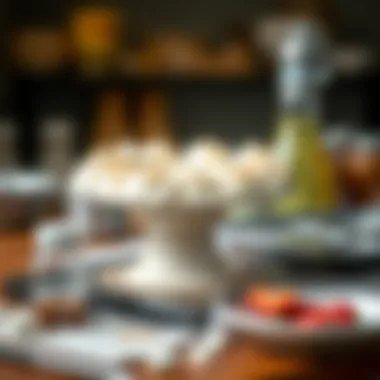
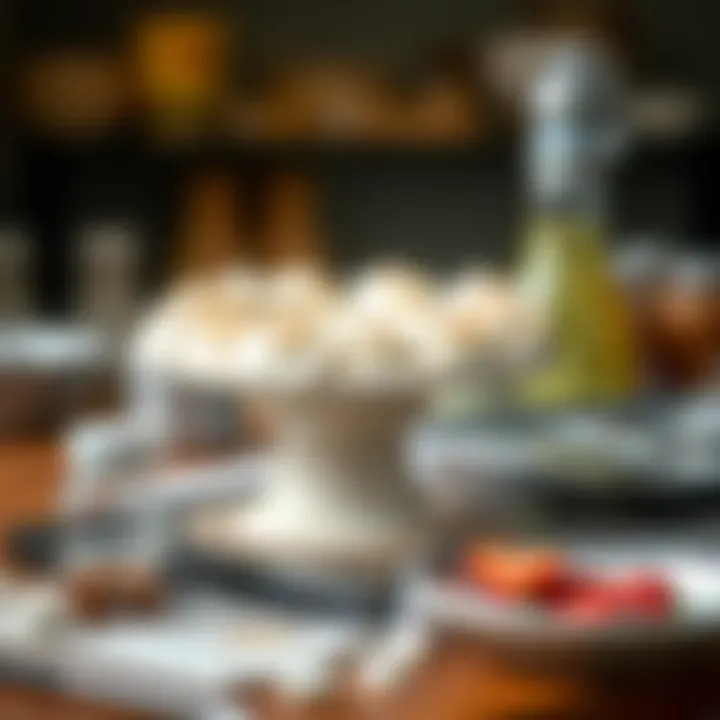
Slider pans, on the other hand, are engineered for simplicity. The very design allows for an effortless removal process. With a gentle push on the slider mechanism, the cake gracefully emerges without fear of tearing. This can maintain its intended structure and aesthetics, allowing for a more appealing finish, especially when showcasing layered cakes or intricate designs. In short, cake pans with sliders usually offer a more reliable baking performance, keeping bakers happy and stressed-free.
Ease of Use
When you step into the kitchen, ease of use can be a major factor that influences your experience. Traditional cake pans might feel familiar but also cumbersome when it comes to maneuvering during the baking and cooling stages. To release a cake, a baker sometimes needs to wrestle with various methods, like inverting the pan, running a knife around the edges, or even cooling it upside-down — methods prone to mishaps.
In contrast, slider variants are a breath of fresh air. Designed for straightforward operation, they allow bakers to focus on the creativity of their baking rather than fretting over the technical aspects. The thumb-friendly sliders enable quick adjustments, significantly cutting down the hassle traditionally involved in release. Furthermore, their contemporary designs can blend seamlessly into kitchens, providing both functionality and style.
"Baking should be about delight, not dread! With slider pans, it can truly be a walk in the park."
— A satisfied home baker
User Experiences and Reviews
User experiences and reviews play a critical role in understanding how cake pans with sliders perform in real-world baking situations. These insights can guide potential buyers, helping them to make informed decisions. After all, when it comes to kitchen tools, it’s not just about glossy advertisements; real feedback formulates a more nuanced picture of usability, efficiency, and overall satisfaction.
Professional Bakers' Insights
When it comes to baking, professional bakers often have extensive experience with various tools, including cake pans with sliders. According to many experts in the culinary field, these innovative pans can significantly streamline the baking process.
For instance, professional baker Emily Baker claims, "The slider feature on these pans has allowed me to easily release delicate cakes without the risk of damage. It’s a game-changer when it comes to intricate designs." This insight suggests that, especially for bakers who create elaborate cake designs, the slider feature doesn't just improve usability; it enhances creativity as well.
Moreover, some bakers emphasize the importance of consistency. James Cook, a pastry chef known for his wedding cakes, stated, "Having an even distribution of heat and ease of removal means my cakes are consistently good. No more lopsided layers!" This points to the inherent advantages cake pans with sliders offer—solving problems that might crop up with traditional pans.
Another consideration that professionals often mention is the cleaning aspect. Many professional chefs appreciate that these pans generally have non-stick coatings, which means a quick clean-up after a grueling day of baking.
Home Bakers' Feedback
Home bakers, too, have a wealth of experiences to share regarding their adventures with slider cake pans. For many, these pans have simplified baking in ways they never thought possible.
Take Sarah, a home baker who often bakes for her children's birthday parties. She said, "I used to dread layers falling apart when taking them out of the pan. The slider makes it so much easier! It feels like magic watching them come out perfectly." This reflects how user-friendly the slider mechanism can be, particularly for those baking at home.
Another perspective comes from Mark, a weekend enthusiast who dabbles in various baking projects. He remarked, "I've tried both traditional and slider pans, and I can say that I won't be going back. The slider pans save time during the cooling process because I can just slide them out without waiting for them to cool completely."
Also, users frequently mention the aesthetic aspect of baking with these pans. Home bakers appreciate that cakes retain their beautiful shape, making them dessert-ready immediately after baking. It’s a win-win situation.
Overall, both professional and home bakers echo a common sentiment: cake pans with sliders not only solve practical baking challenges but also enhance the overall baking experience. Feedback from these diverse users underscores the importance of innovation in kitchenware, showing that modern tools can significantly impact the traditional art of baking.
Choosing the Right Cake Pan with Slider
When it comes to baking, the tools you select make a world of difference, especially with something as specific as cake pans with sliders. Selecting the right cake pan isn’t just about crafting an edible masterpiece; it’s about ensuring that the end result is not only delicious but also visually appealing and easy to manage. A cake pan with a slider allows for more than just easier cake removal; it opens the door to creativity and precision in your baking endeavors.
Consideration for a cake pan with slider boils down to understanding both your personal baking habits and what specific attributes the pan must have. With various materials, sizes, and designs flooding the market, knowing what fits within your baking style can greatly enhance your kitchen experience. And let’s face it, any baker worth their salt knows that a good tool makes half the battle in the kitchen a piece of cake.
Identifying Personal Needs
Before you rush out to grab that shiny new cake pan, it's wise to reflect on what you need. Are you someone who constantly bakes elaborate tiered cakes for a party, or do you prefer whipping up simple sheet cakes for family dinners? For the latter, a rectangular cake pan might suffice, while more intricate designs will benefit from a round one.
Here are a few factors to ponder:
- Baking Frequency: If you bake often, investing in a high-quality pan that can withstand regular use is smart.
- Portion Sizes: Think about how many mouths you're trying to feed. Smaller pans for intimate gatherings, larger for celebrations.
- Baking Skills: If you're still getting the hang of things, a versatile pan will give you room for error without compromising your efforts.
The right cake pan should feel like an extension of you, aligning with your culinary rhythm. Don't skip this step; getting this right will save you a world of frustration down the line.
Budget Considerations
Let's talk dollars and cents. The market for cake pans with sliders spans a wide range, from tempting high-end brands to budget-friendly alternatives. Setting a clear budget can help narrow your options but remember that cheaper doesn't always mean better. Sometimes, investing a bit more can yield significant returns in durability and performance.
Budgeting tips include:
- Determine Your Price Range: Look at what you’re willing to spend, and don’t lose your head over an initial high price. A pricier pan may last you years, thwarting the need for replacements.
- Read Reviews: Massive savings on a no-name product aren't worth it if reviews reveal it loses its non-stick ability after one use.
- Consider Deals: Sometimes, brands run promotions that combine quality with savings. Keep an eye out!
It's important to view your cake pan as an investment in your baking journey. Spending wisely can lead to equipment that not only enhances your baking quality but also your overall enjoyment of the craft.
Culmination: The Future of Cake Baking
As we reflect on the versatility of cake pans with sliders, it becomes clear that these innovative baking tools are not merely a passing trend; they symbolize a significant shift in how we approach cake baking. By integrating slider mechanisms into their design, these pans solve several common baking dilemmas, making the process not only more manageable but more enjoyable.
Culinary Trends and Innovations
In recent years, culinary trends have seen an expansive focus on convenience and efficiency, and cake pans with sliders perfectly encapsulate this evolution. The rise of home baking during the pandemic has also fueled interest in advanced bakeware. Bakers are increasingly seeking products that enhance their creativity while also delivering consistently high-quality results.
Here are some key innovations that have emerged alongside sliders in cake pans:
- Interchangeable Components: New designs are allowing components of cake pans to be swapped. This enables bakers to customize their pans for different cake styles, from layered to novelty shapes.
- Sustainable Materials: There’s a growing trend towards using environmentally friendly materials in manufacturing cake pans. Manufacturers are responding to consumer demand for sustainable options, ensuring that quality baking tools don’t harm the planet.
- Digital Integration: While sliders provide a mechanical solution, the future might see the incorporation of smart technology. Imagine app-controlled settings determining the ideal baking conditions based on the selected cake recipe!
These trends reflect not only a change in aesthetics or functions but also an evolution in how bakers, both amateur and professional, interact with their tools. As the culinary world continues to embrace technology, the cake pan with a slider could become an essential part of any baker's toolkit.
Final Thoughts on Cake Pans with Sliders
In closing, cake pans with sliders offer an intriguing glimpse into the future of baking. The convenience they provide allows bakers to focus on creativity rather than worrying about the release of their cakes.
To summarize the benefits:
- Ease of Use: Sliders simplify the removal process, making it hassle-free to present your creations.
- Versatile Designs: They open up avenues for multiple baking techniques, enhancing artistic expression.
- High Quality Outcomes: The consistent results that come with using these pans ensure that cake lovers experience delight with every slice.
Ultimately, as baking technology advances and the materials used in cookware improve, cake pans with sliders will likely become the norm rather than the exception. It’s a testament to innovation in an age where both functionality and design are crucial.
"The future of cake baking is not just about making desserts; it's about transforming the entire baking experience into something more delightful and efficient."
For more insights into baking innovations, consider checking out resources from Wikipedia, Britannica, and various baking forums on Reddit.







